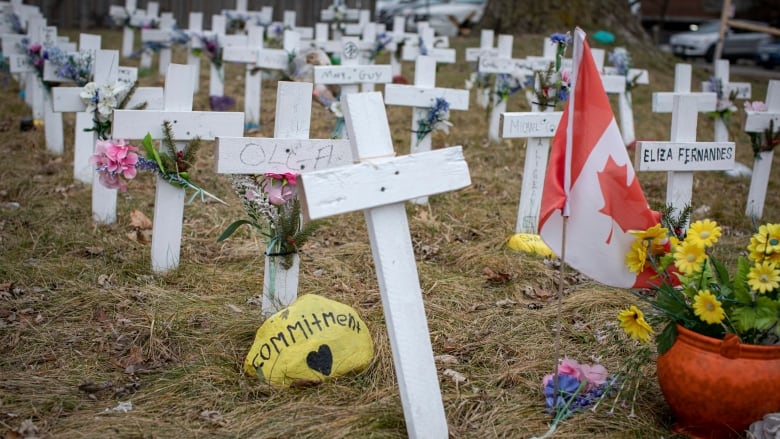Excess mortality: What the data tells us about COVID-19 in Saskatchewan
It wasn't until the fall of 2020 that Saskatchewan started to see rising figures

Data recently released by Statistics Canada is giving Saskatchewana better idea of how the virus has affected the province.
It also pokes holes in an argument often used by conspiracy theorists in the early days of the pandemic that continuesto persist: The virus isn't deadly enough to justify the actions taken by health officials.
The newfigures record excess mortality, which happens when more deaths occur during a certain period of time than what would be typically expected.
Despite its usefulness, excess mortality can only be calculated after-the-fact once data is recorded and tallied.That takes time but it doesn't mean it's not useful, at least one health professional has told the CBC.
"It's a useful kind of like proofreading tool to check against what we think is going on," said Paul Masiowski, a neurologist in Saskatoon.
Excess mortality
The pandemic arrived in Saskatchewan in a relatively mild manner when compared with the hardest-hit provinces, such as Ontario and Quebec. Saskatchewan did not record its first COVID-19-related deaths until March 30, 2020.
The deaths appear to have pushed the number of deaths above the projected amount, resulting in excess mortality for the week of April 4.
But it's important to remember that a spike in deaths for one week isn't necessarily a cause for concern,Masiowskicautions.
"The number that they sort of expect becomes kind of like a projection, but not an absolute hard limit," he said."It's not the case that the minute there's one extra or two extra deaths above that number, that something mysteriously terrible has happened."
It really begins to be concerning when the number of recorded deaths outpaces the number of projected deaths and begins to show a sustained and developing trend.
In Saskatchewan, the number of COVID-19 deaths rose over the spring and summer, but in comparatively small numbers.
"We had a few people get sick in the hospital and some of them did pass away from the virus, but it wasn't a huge number, especially compared to other places," Masiowskisaid, adding the data confirms what he saw first-hand in hospitals or what other doctors know to be anecdotally true.
I think, you know, if there's any comfort in this kind of tragedy and these sorts of cold statistical numbers, it's the idea that that we can sort of think, well, we did have a legitimately fearful kind of foe to confront here.- Paul Masiowski, neurologist
"When we say that we're spotting some sort of excess mortality, what we're saying is we're spotting the known bad effect of the pandemic," he said. "That number is showing us what we already know from experience and what's been documented day-by-day as we went along."
It wasn't until the fall of 2020 right around Thanksgiving that Saskatchewan started to see excess mortality.
In those months Saskatchewan saw nineper cent more deaths than expected.
Masiowski says that figure corresponds with the data the provincial government released on a daily basis during that time period.
"[The data from Statistics Canada] does show an increased death rate in Saskatchewan toward the end of the year, starting basically after Thanksgiving. And again, that corresponds to our official numbers of case reports," he said.
Excess mortality to climb with new data
However, Masiowskisays, the data released by Statistics Canada doesn't capture the deadliest part of the COVID-19 pandemic in Saskatchewan.
"January and February had our highest death rates so far from the virus," he said.
Data on excess deaths from the federal organization is only available to about mid-December.However, starting in November the number of COVID-19 deaths began to climb in Saskatchewan.
On Nov. 28, the province had recorded 45 COVID-19-related deaths. A month later that figure had more than tripled, climbing to 141 deaths.
March saw the number of deaths surpass 300 and it continues to climb on a near-daily basis.
The data available from Statistics Canada already indicates COVID-19 is a deadly virus.
However, until the federal agencyprovides updated figures on excess mortality it's hard to say what lessons can be drawn from the deadliest part of the pandemic in the the province.
Masiowski says that it's a reasonable inference that the data, when revealed, will show a large increase in excess mortality in Saskatchewan in the first months of 2021
But looking back at the data available can already verify lessons, he says.
"Excess mortality data is a very clear proof of how deadly this virus actually was. And it's worth pointing out it was that deadly, despite our strong ongoing efforts to restrain it and to limit those kinds of impacts," the neurologist said.
The first wave of COVID-19 grabbed hold in Ontario and Quebec before it was substantially controlled, Masiowski added, saying the excess death curves went far above what would have been expected.
"I think, you know, if there's any comfort in this kind of tragedy and these sorts of cold statistical numbers, it's the idea that that we can sort of think, well, we did have a legitimately fearful kind of foe to confront here."
But Masiowski says it's important to avoid getting lost in the numbers, and to remember that each person who died due to COVID-19 was significant to someone.
"They're worth taking seriously even only one or two deaths is an important thing," Masiowski said. "Anybody who died of COVID here in Saskatchewan, that's a tragedy for them and for their family and friends."












_(720p).jpg)


 OFFICIAL HD MUSIC VIDEO.jpg)
.jpg)



























































































